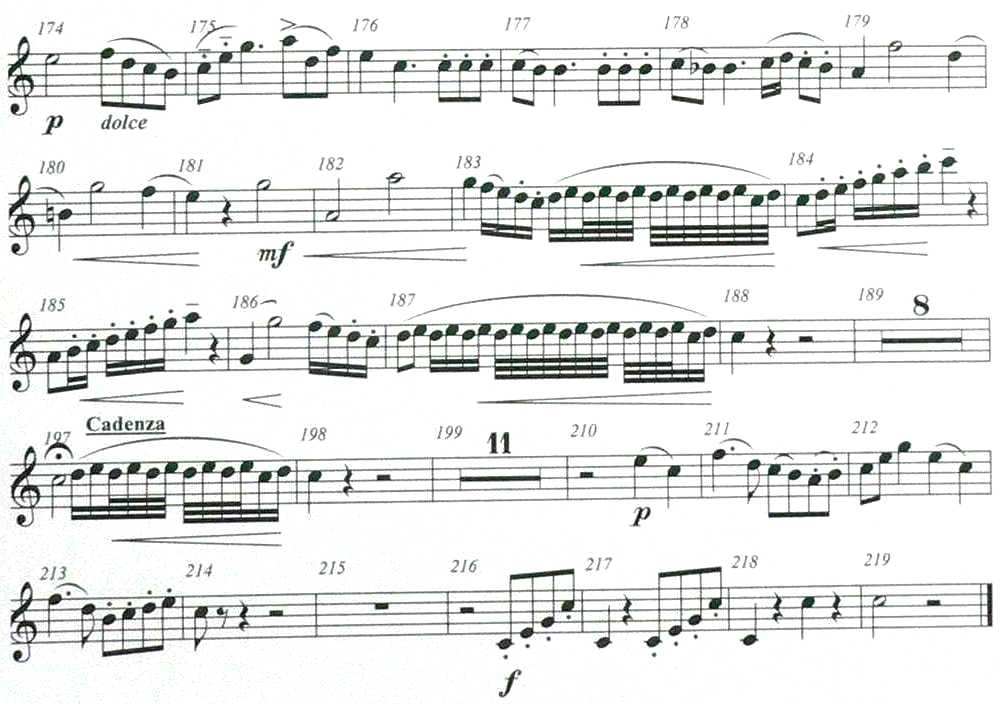|
3eme Concerto pour le Cor op.106 (K.495) |
Ein Waldhorn Konzert für den Leitgeb |
|
How to play this concert |
Interpretationsanleitung p.7 |
|
|
|
|
Now take care that you do not fire all your ammunition too early, keep something for the last run & the ending trill. The entrance at M.174 must be soft, the d2 on the F-horn as a open note. Sing this melody. Here the eb2s ask for the T1 execution (much better in tune, and you will find it very practical to do so.). The sequence bb1-d2-f2 in M. 175 is much easier if you do it on the F-side, using the first valve except for the d2 (F). Take care that you do not rush with the repeated eights in M.176/177, special if you shorten the dotted quarters. Execute the sixteenths in M.178 carefully in rhythm (d2 = F0) & tongue the last a1 in the same measure for clarity. Ooops, I forgot to tell you, where you should breath: at first instead of the dot on the quarter note in M.177, second before the upbeat to M.180. Increase the dynamic level a bit during M.179/180 & gain until the high bb2, but gradually. Set the f2 in M.181 with T1, the g1 with F0, the g2 with T0, f2 with T1 again, to continue with the four sixteenths eb2 (T1) & all other three on the F-side to arrive for the trill on the c2 on the F-side for a beautiful end trill, starting with the main note c, but build it up quickly, as you have only a half note & you must care for the Abschlag notes. This trill has no anticipating grace note as the melody just had passed the main note with the last sixteenth note bb1 just before the trill. I forgot to mention that the four sixteenths must be played in the appropriate two-slurred-two-dotted-mode for absolute clarity. The full octave run in M.184 is rather tricky as you might arrive somewhat exhausted. But you are to be blamed for that, as you have fired too much from your ammunition earlier. I warned you. To execute the run absolutely clear & without much difficulty, do it on the Bb-side, all staccato, but light, light crescendo, returning to the earlier dynamic level, run uphill again in M.185. Do not forget to stay well on the top quarter notes. And up again, the octave jump f1-f2, which might be done in two different ways: Set the lower f1 firmly on the F1 first, shorten it a bit & enter with the higher f2 on T1 with a light accent, or second: slur it up in typical horn player manner. The down run sixteenths might be performed as in M.183, but there is a difference for the trill. Here now you have more time to build up a beautiful lip trill on the F-horn, but increase tempo beat by beat , doubling the speed, but leave time enough for the Abschlag. For the trills beginning there is no grace note, as the same rules apply as in the other c2-d2 trill.
|
Gib acht, nicht alle Munition zu früh zu verfeuern, bewahre etwas für den letzten Lauf und den Triller. Der Einsatz in T174 sehr weich, das d2 als offenen F-Horn-Ton. Singe diese Melodie. Hier verlangt das es2 wieder T1 (stimmt sehr gut und ist sehr praktisch). Die Tonfolge b1-d2-f2 ist auf der F-Seite viel leichter; nimm das erste Ventil, ausser für das d2. Achte darauf, dass die wieder-holten Achtel in T.176/77 nicht laufen, besonders, wenn Du die punktierten Viertel abkürzt. Die Sechzehntel in T.178 rhythmisch sorgfältig (d2 = F0), das a1 im gleichen Takt zwecks Klarheit leicht angestossen. Oh, ich habe vergessen, den "Atempunkt" zu erwähnen: erst anstelle des Punktes der punktierten ¼ in T177, dann vor dem Auftakt zu T180. Erhöhe die Lautstärke während der Takte 179/80 etwas, und nochmals schrittweise bis zum b2. Setze das f2 in T181 mit T1, das g1 mit F0, das g2 mit T0 und das f2 wieder mit T1, dann die vier Sechzehntel (das es2 mit T1, die anderen drei auf der F-Seite) und erreiche den Triller c2 auf der F-Seite für einen wunderschönen Abschlusstriller, beginnend mit c, baue ihn aber schnell auf, da nur eine halbe Note Zeit dafür bleibt. Ausserdem braucht man Platz für den Abschlag. Der Triller braucht keinen einleitenden Vorschlag, da die Hauptnote bereits im Verlauf vorher mit dem b1 unmittelbar vor dem Triller unterschritten wurde. Jene vier Sechzehntel sind in der entsprechenden zwei-gebunden-zwei-gestossen Manier, auszuführen. Der volle Oktavenlauf T.184 ist ziemlich trickig, da Du schon ziemlich ausgepumpt ankommst. Die Schuld ist Dir selbst zuzuschreiben, da Du schon Deine Munition zu früh verschossen hast. Ich habe gewarnt. Damit der Lauf ganz klar und ohne Schwierigkeit kommt, nimmt man ihn ganz auf der B-Seite, alles staccato aber leicht mit leichtem crescendo, und wieder in der ursprünglichen Lautstärke mit dem zweiten Lauf in T.185. Vergiss nicht, schön auf dem obersten Ton "stehen zu bleiben". Und weiter mit dem Oktavsprung f1-f2, den man auf zwei Arten ausführen kann: 1) setze das untere f1 fest hin (F1), verkürze es etwas und komm mit dem oberen f2 auf T1 mit leichtem Akzent gut an, oder 2) binde in typischer Hornmanier hinauf. Die abwärtsführenden Sechzehntel in bewährter Weise wie in T.183, beachte aber den unterschiedlichen Triller. Hier gibt es mehr Zeit, einen schönen Lippentriller aufzubauen, verdoppele aber das Tempo Schlag für Schlag, lasse aber genug Raum für den Abschlag. Es gibt wieder keine einleitende Vorschlagsnote nach den gleichen Regeln wie den anderen c2-d2 Trillern. |
